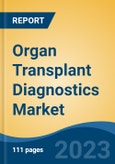Free Webex Call
The global organ transplant diagnostics market is anticipated to observe impressive growth during the forecast period 2023-2027. The major factors include the growing prevalence of chronic diseases, the increase in the number of organ transplantation surgeries, and the adoption of advanced technology in the field of transplant diagnostics, which are impelling the growth of the market. Organ transplantation is a medical technique in which an organ is removed from one body and placed in a recipient’s body to substitute a damaged or missing organ. The other factors supporting the market’s growth are, increasing government initiatives for spreading awareness, the rising geriatric population, the rising incidence of organ failure, high demand for molecular diagnostic tests, the surging investment and expenditure in healthcare and diagnostics, growing number of the organ transplant procedure, growing launch of programs & new product development in organ transplant diagnosis, and rise in research and development activities.Speak directly to the analyst to clarify any post sales queries you may have.
10% Free customizationThis report comes with 10% free customization, enabling you to add data that meets your specific business needs.
Rising Incidences of Chronic diseases
The increasing occurrence of chronic diseases, such as diabetes, cardiovascular diseases, and others, across the globe, are bolstering the growth of the market. This is attributed to the increased risk of organ failure among patients suffering from chronic diseases. According to the WHO, Cardiovascular diseases (CVDs) are the leading cause of death worldwide, taking approximately 17.9 million lives each year. Also, the geriatric population is more prone to organ malfunction, especially the liver, heart, and kidney, thus, in turn, driving the growth of the market. As per the United States Government Information on Organ Donation and Transplantation, in 2019, 63 % of those who had organ transplants were aged 50 or older, and 21% of overall organ transplant individuals were aged 65 and above.Increasing Awareness and Increase in the Number of Organ Transplantation Surgeries
Over the past few years, people are becoming more aware of organ transplantation, which is augmenting the growth of the market. Owing to the awareness among the masses, people are going for organ transplantation surgeries, which is fueling the growth of the market. Various initiatives are taken by the government and non-government organizations to make people aware of organ transplantation. Moreover, the rise in number of organ transplantation surgeries is fueling the growth of the market. Owing to the increase in the number of patients with organ failure, the demand for transplant procedures is rising, which is facilitating the growth of the market. According to Health Resources and Services Administration, in 2019, about 112,568 people in the U.S. required organ transplantation.Market Segmentation
The global organ transplant diagnostics market is segmented into component, transplant type, technology, application, end-user, and company. Based on components, the market is divided into kits & assays, consumables, and services. Based on transplant type, the market is divided into solid organ transplants and stem cell transplants. Based on technology, the market is segmented into molecular technologies, serology, flow cytometry, and others. Based on application, the market is divided into clinical diagnostics and translational research. Based on end-user, the market is divided into hospitals & transplant centers, academic & research institutions, and others. In terms of country, the United States is expected to be a lucrative market in the forecast period due to the rise in the number of organ transplantation surgeries in the country.Market Players
Illumina, Inc., Thermo Fischer Scientific, Inc., Abbott Laboratories, Inc., Quest Diagnostics, Inc., F. Hoffmann-La Roche AG, Bio-Rad Laboratories, Inc., Laboratory Corporation of America Holdings, bioMérieux S.A., CareDx, Inc, and Immucor, Inc. are some of the leading companies operating in the market.Report Scope:
In this report, global organ transplant diagnostics market has been segmented into the following categories, in addition to the industry trends which have also been detailed below:Organ Transplant Diagnostics Market, By Component:
- Kits & Assays
- Consumables
- Services
Organ Transplant Diagnostics Market, By Transplant Type:
- Solid Organ Transplant
- Stem Cell Transplant
Organ Transplant Diagnostics Market, By Technology:
- Molecular Technologies
- Serology
- Flow Cytometry
- Others
Organ Transplant Diagnostics Market, By Application:
- Clinical Diagnostics
- Translational Research
Organ Transplant Diagnostics Market, By End User:
- Hospitals & Transplant Centers
- Academic & Research Institutions
- Others
Organ Transplant Diagnostics Market, By Region:
- North America
- United States
- Canada
- Mexico
- Asia-Pacific
- China
- India
- Japan
- Australia
- South Korea
- Europe & CIS
- Germany
- France
- United Kingdom
- Spain
- Italy
- South America
- Brazil
- Argentina
- Colombia
- Middle East & Africa
- South Africa
- Saudi Arabia
- UAE
- Turkey
- Egypt
Competitive Landscape
Company Profiles: Detailed analysis of the major companies present in Global Organ Transplant Diagnostics Market
Available Customizations:
With the given market data, the publisher offers customizations according to a company’s specific needs.This product will be delivered within 1-3 business days.
Table of Contents
1. Product Overview2. Research Methodology3. Executive Summary4. Impact of COVID-19 on Global Organ Transplant Diagnostics Market5. Voice of Customer13. Market Trends & Developments15. Strategic Recommendations
6. Global Organ Transplant Diagnostics Market Outlook
7. North America Organ Transplant Diagnostics Market Outlook
8. Europe Organ Transplant Diagnostics Market Outlook
9. Asia-Pacific Organ Transplant Diagnostics Market Outlook
10. South America Organ Transplant Diagnostics Market Outlook
11. Middle East and Africa Organ Transplant Diagnostics Market Outlook
12. Market Dynamics
14. Competitive Landscape








